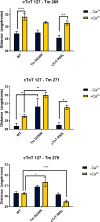Clinically Divergent Mutation Effects on the Structure and Function of the Human Cardiac Tropomyosin Overlap
- PMID: 28603979
- PMCID: PMC5575768
- DOI: 10.1021/acs.biochem.7b00266
Clinically Divergent Mutation Effects on the Structure and Function of the Human Cardiac Tropomyosin Overlap
Abstract
The progression of genetically inherited cardiomyopathies from an altered protein structure to clinical presentation of disease is not well understood. One of the main roadblocks to mechanistic insight remains a lack of high-resolution structural information about multiprotein complexes within the cardiac sarcomere. One example is the tropomyosin (Tm) overlap region of the thin filament that is crucial for the function of the cardiac sarcomere. To address this central question, we devised coupled experimental and computational modalities to characterize the baseline function and structure of the Tm overlap, as well as the effects of mutations causing divergent patterns of ventricular remodeling on both structure and function. Because the Tm overlap contributes to the cooperativity of myofilament activation, we hypothesized that mutations that enhance the interactions between overlap proteins result in more cooperativity, and conversely, those that weaken interaction between these elements lower cooperativity. Our results suggest that the Tm overlap region is affected differentially by dilated cardiomyopathy-associated Tm D230N and hypertrophic cardiomyopathy-associated human cardiac troponin T (cTnT) R92L. The Tm D230N mutation compacts the Tm overlap region, increasing the cooperativity of the Tm filament, contributing to a dilated cardiomyopathy phenotype. The cTnT R92L mutation causes weakened interactions closer to the N-terminal end of the overlap, resulting in decreased cooperativity. These studies demonstrate that mutations with differential phenotypes exert opposite effects on the Tm-Tn overlap, and that these effects can be directly correlated to a molecular level understanding of the structure and dynamics of the component proteins.
Figures










Similar articles
-
The structural basis of alpha-tropomyosin linked (Asp230Asn) familial dilated cardiomyopathy.J Mol Cell Cardiol. 2017 Jul;108:127-137. doi: 10.1016/j.yjmcc.2017.06.001. Epub 2017 Jun 7. J Mol Cell Cardiol. 2017. PMID: 28600229 Free PMC article.
-
Ca(2+)-regulatory function of the inhibitory peptide region of cardiac troponin I is aided by the C-terminus of cardiac troponin T: Effects of familial hypertrophic cardiomyopathy mutations cTnI R145G and cTnT R278C, alone and in combination, on filament sliding.Arch Biochem Biophys. 2014 Jun 15;552-553:11-20. doi: 10.1016/j.abb.2013.12.021. Epub 2014 Jan 10. Arch Biochem Biophys. 2014. PMID: 24418317 Free PMC article.
-
Cardiac and skeletal myopathies: can genotype explain phenotype?J Muscle Res Cell Motil. 2001;22(1):1-4. doi: 10.1023/a:1010355716511. J Muscle Res Cell Motil. 2001. PMID: 11563546 Review.
-
Dilated cardiomyopathy mutations in three thin filament regulatory proteins result in a common functional phenotype.J Biol Chem. 2005 Aug 5;280(31):28498-506. doi: 10.1074/jbc.M412281200. Epub 2005 May 27. J Biol Chem. 2005. PMID: 15923195
-
Inherited cardiomyopathies as a troponin disease.Jpn J Physiol. 2004 Aug;54(4):307-18. doi: 10.2170/jjphysiol.54.307. Jpn J Physiol. 2004. PMID: 15631686 Review.
Cited by
-
FRET-based analysis of the cardiac troponin T linker region reveals the structural basis of the hypertrophic cardiomyopathy-causing Δ160E mutation.J Biol Chem. 2019 Oct 4;294(40):14634-14647. doi: 10.1074/jbc.RA118.005098. Epub 2019 Aug 6. J Biol Chem. 2019. PMID: 31387947 Free PMC article.
-
The Emerging Role of the RBM20 and PTBP1 Ribonucleoproteins in Heart Development and Cardiovascular Diseases.Genes (Basel). 2020 Apr 8;11(4):402. doi: 10.3390/genes11040402. Genes (Basel). 2020. PMID: 32276354 Free PMC article. Review.
-
Arg92Leu-cTnT Alters the cTnC-cTnI Interface Disrupting PKA-Mediated Relaxation.Circ Res. 2024 Oct 25;135(10):974-989. doi: 10.1161/CIRCRESAHA.124.325223. Epub 2024 Sep 27. Circ Res. 2024. PMID: 39328062
-
Complex roads from genotype to phenotype in dilated cardiomyopathy: scientific update from the Working Group of Myocardial Function of the European Society of Cardiology.Cardiovasc Res. 2018 Aug 1;114(10):1287-1303. doi: 10.1093/cvr/cvy122. Cardiovasc Res. 2018. PMID: 29800419 Free PMC article. Review.
-
Modeling the effects of thin filament near-neighbor cooperative interactions in mammalian myocardium.J Gen Physiol. 2025 Mar 3;157(2):e202413582. doi: 10.1085/jgp.202413582. Epub 2025 Jan 27. J Gen Physiol. 2025. PMID: 39869069 Free PMC article.
References
-
- Holmes KC, Lehman W. Gestalt-binding of tropomyosin to actin filaments. J. Muscle Res. Cell Motil. 2008;29:213–219. - PubMed
-
- Tardiff JC. Tropomyosin and dilated cardiomyopathy: revenge of the actinomyosin ″gatekeeper″. J. Am. Coll. Cardiol. 2010;55:330–332. - PubMed
-
- Bremel RD, Weber A. Cooperation within actin filament in vertebrate skeletal muscle. Nat. New Biol. 1972;238:97–101. - PubMed
-
- Weber A, Murray JM. Molecular control mechanisms in muscle contraction. Physiol. Rev. 1973;53:612–673. - PubMed
-
- Tobacman LS, Sawyer D. Calcium binds cooperatively to the regulatory sites of the cardiac thin filament. J. Biol. Chem. 1990;265:931–939. - PubMed
Publication types
MeSH terms
Substances
Supplementary concepts
Grants and funding
LinkOut - more resources
Full Text Sources
Other Literature Sources
Research Materials
Miscellaneous

